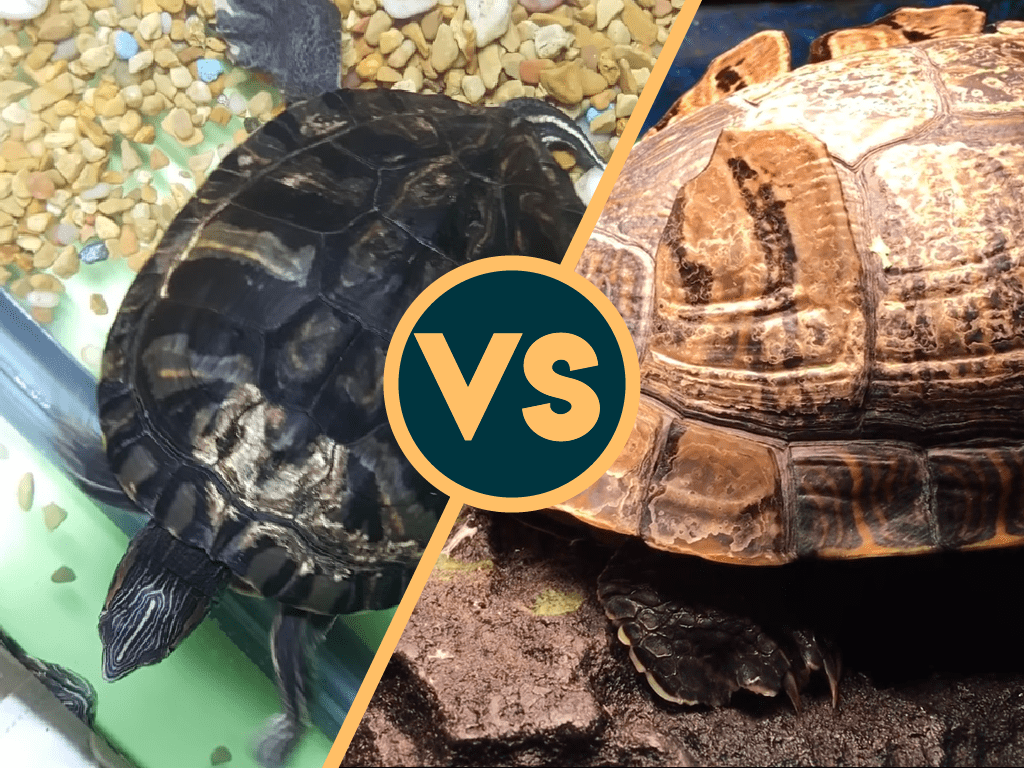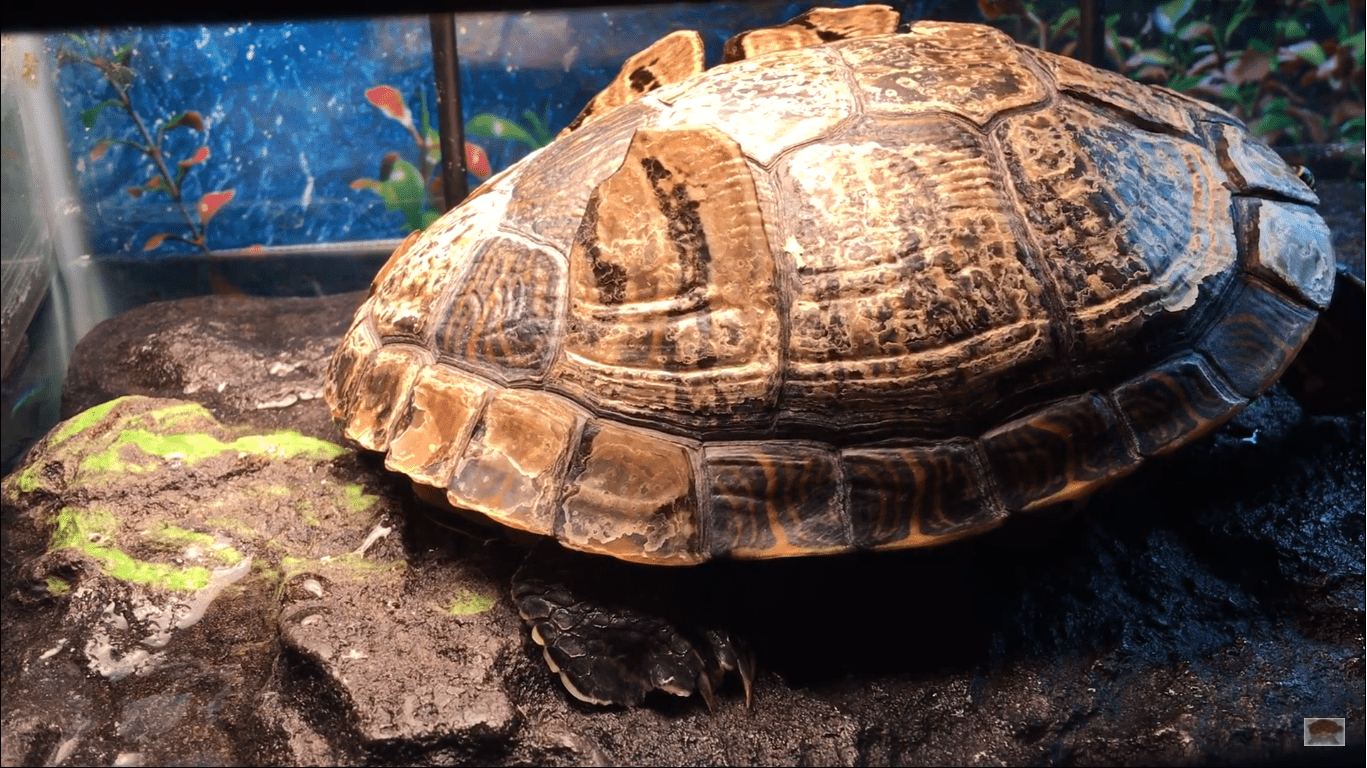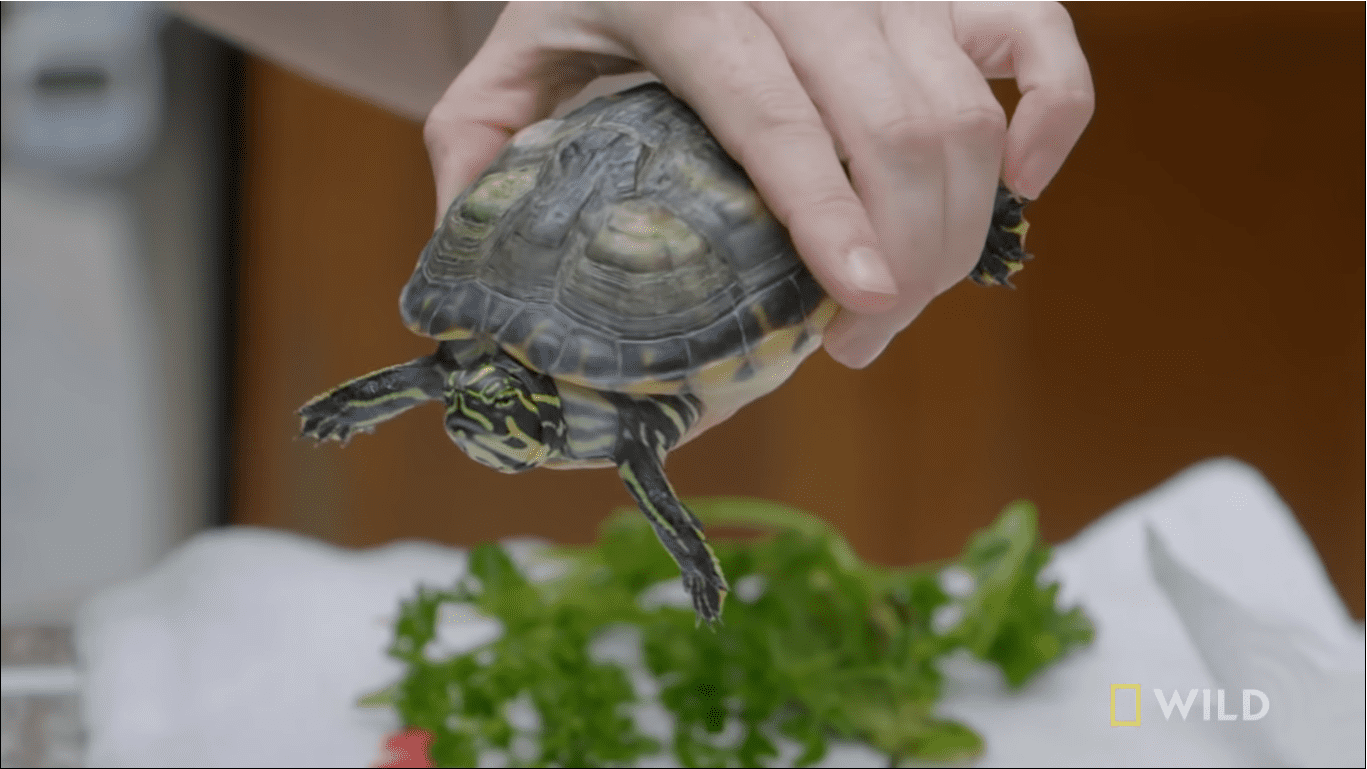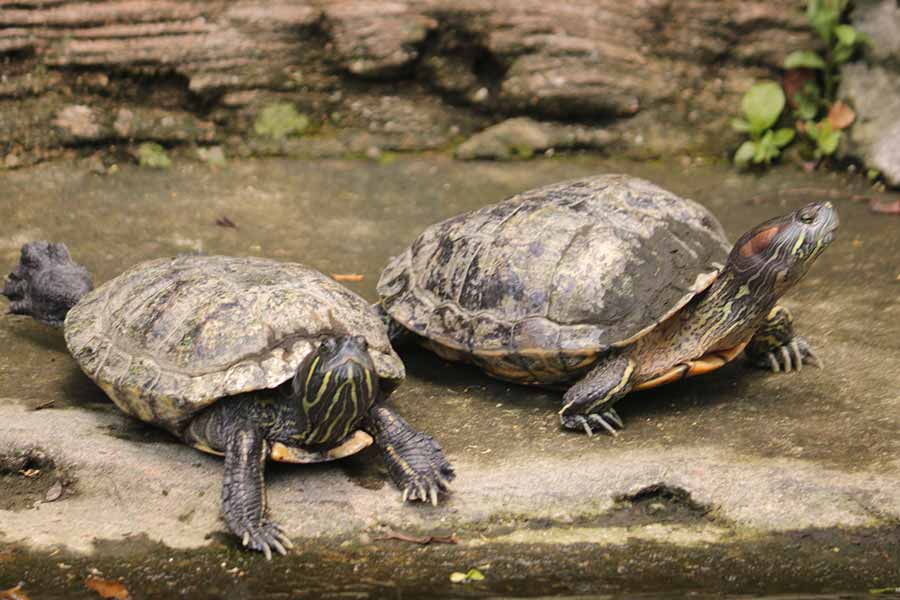
It can be quite alarming to see parts of your pet turtle’s shell start to flake off, turn white, or feel soft.
Sometimes, the peeling or flaking of the shell and white spots are completely benign and part of the natural cycle of life; however, in some cases, they can be cause for serious concern.
This article will help you learn the differences between shell rot and turtle shell shedding.
Essential Vocab
First, let’s sort out some vocabulary so that you understand everything in this article if you are a first-time turtle owner:
- Plastron: the underside or belly of your turtle’s shell
- Carapace: the topside or back of your turtle’s shell
- Scutes: the individual bones that make up your turtle’s shell
- Keratin: the natural compound that covers the scutes on your turtle’s shell; it is the same material that makes up your nails and hair as well as many other animals’ hooves, horns, and claws!
Keep reading to find out how to tell the difference between shell rot vs shedding and how you can treat it!
Key Takeaway
Shell shedding or turtle shell peeling happens naturally, even if it looks a bit strange to see the pieces of the shell start to peel off. Shell rot, on the other hand, is caused by a bacterial or fungal infection of the keratin covering the shell.
Main Differences Between Turtle Shell Rot vs Shedding
The main differences between turtle shell rot vs shedding are:
- Shell shedding occurs naturally as a result of growth or injury, whereas shell rot occurs when there is a fungal or bacterial infection.
- As a pet owner you don’t usually need to do anything if you see your turtle shedding its shell, whereas you need to treat shell rot as soon as you spot it.
- Shell shedding will not harm your turtle, whereas shell rot can become fatal if left untreated.
Shell shedding will happen throughout your turtle’s life as it grows or heals from injuries to its shell. Rotting can be avoided through careful care, and mild cases can be treated at home.
Ask The Expert

Do turtles shed?
As you know turtles have a shell that protects them from predators. This shell has a top and bottom section, the top is called the carapace and the bottom is called the plastron. Each of these areas are covered in sectioned scales, also known as scutes. The shell of a turtle grows with the animal, and as their size gets larger the original layer of scute begins to flake and come off. Underneath the scute that has shed off is a beautiful new scute.
This process is similar to the human cycle of growing out of your baby teeth and into your adult ones except in this case when the turtle continues to grow throughout their life, they lose many layers of scutes and they always have a new scute that comes behind. A unique process for scute shedding also happens when these animals are adults and have finished growing. These shells work to protect the animal from shell rot and parasites by being able to shed the infected sections of their scutes.
Like other reptiles, turtles also shed their skin in patches. This process is due to general growth, but is also part of keeping the animal healthy from skin infections! Generally, you do not need to worry if your turtle’s shell or skin begins to flake, just make sure to always let it fall off naturally and never pull on any loose shed.
I’m Marina and I have an environmental science degree with a focus on herp ecology along with 20+ years of reptile husbandry experience. I have worked with over 250 different reptile species and have even studied many of them in their native habitats inside and outside of the United States.
Follow Marina on TikTok, LinkedIn and Instagram.
Shell Rot vs Shell Shedding: Overview
Establishing what is happening to your turtle's shell is important. After all, turtles cannot tell you if they are in pain or feeling sick.
So it's up to you as the owner to keep a careful watch on them and any health issues that may arise.
To properly diagnose shell rot versus simple shedding, you will need to look at your turtle's shell carefully to see if they are shedding or peeling and look out for other signs of
Shell Shedding
Shell shedding is a natural process that happens to all healthy turtles. Just like snakes shed their skin when they get larger, turtles shed the outer layer of their scutes as they grow (which is why it is sometimes known as scute shedding).
Scutes all over the shell on both the carapace and the plastron will shed from time to time. Sometimes it will look like a gradual peeling of the shell.
Healthy Shedding
When a turtle sheds its scutes because of growth, it may happen all at once or in stages. If your turtle is shedding a specific scute or area of scutes, it may be because of an injury.
This is a completely natural process, and you should not worry at all when your turtle sheds! Once your turtle has shed its scutes, try to quickly fish them out of the tank or enclosure before they get a chance to gobble them up.
Unhealthy Turtle Shell Shedding
Even though it is a natural process, there are times when shedding can potentially indicate underlying health problems.
For starters, the scutes should peel off as a single piece. If they are peeling off in clumps or breaking off or crumbling into little pieces, this could indicate a calcium deficiency, and you should take them to a vet.
Another sign of abnormal shedding is when the same scute or set of scutes are peeling off layer after layer without stopping. This excessive shell peeling could indicate that there is an infection or damage to the shell your turtle is trying to fix. In this case, take your turtle to the vet.
Shell Rot
Shell rot is definitely not a natural or healthy process! However, it can be a fairly common issue even for experienced owners.
Shell rot is caused by a fungal or bacterial infection in the keratin layer of a turtle's shell. The infection eats away at the keratin layer and into the bone of the shell, and it will eventually spread to the whole shell if left untreated.
In extreme circumstances shell rot can lead to septicemic cutaneous ulcerative shell disease which is where bacteria gets into the turtle's bloodstream which can be fatal.
Most cases of shell rot occur on the plastron and not the carapace because it is more difficult to dry out properly during basking.
In aquatic turtles, shell rot can also be caused by algae that attaches to the shell of the turtle.

How to Spot Shell Rot
Signs of shell rot include:
- Soft spots or pink, red or white patches
- An unpleasant odor or foul smells coming from the shell
- Turtle shell flaking or softening
- Reddish fluid under the shell plates
- Red or pink ulcers
- Bloody discharge
- Exposed bone visible under the shell plates in extreme instances
- Other signs of illness like a lack of appetite or sluggishness
In the early stages, you might spot softening or flaking plates, a foul smelling odor, or a slimy fluid under the shell.
As shell rot progresses, it will start to form small pits under the shell. The shell may start to look uneven, like something is eating away at it.
In extreme cases, shell plates may start to disintegrate or fall off exposing bone. This can allow bacteria to get into the bloodstream leading to ulcerative shell disease.

Common Reasons for Turtle Shell Rot
The most common reasons for shell rot are:
Shell Damage
Turtles can often damage their shells through fighting with other turtles or even by injuring themselves on sharp rocks in their tanks. But sometimes cracks can appear in their shells due to problems with their environment such as too little or too much humidity.
Once your turtle has a damaged shell it is much easier for bacteria and fungus to get in.
Poor Hygiene
Poor water conditions or unhygienic water creates the perfect conditions for parasitic infections to develop. Your turtle may have dirty water because a filter is faulty or there is cross-contamination happening between reptiles because of dirty tools or pipes.
The Shell Not Drying Out
Your turtle may not be drying out its shell completely because it does not have access to a basking spot, the basking spot is difficult to get to, or the basking spot is too humid. This can lead to harmful bacteria growing under the shell.
Lack of UVB Rays
Your turtle may not be getting enough UVB rays because it does not have a UV light, the UVB has run out or is weak, or your turtle is competing for the basking spot under the UVB light and is losing to other turtles.
Poor Nutrition
A poor diet can lead to weakened or soft scutes which makes it easier for the shell to become damaged and for bacteria and fungus to get in. A lack of calcium is one of the most serious nutritional deficiencies.
How to Avoid Shell Rot
Follow these practical tips to keep your turtle happy and avoid shell rot:
Clean Water
It's essential that you make sure your turtle has fresh water at all times. That means regularly cleaning and refilling their drinking water and replacing the water filter regularly if you have an aquatic turtle like a Red-eared slider.
Keep the Enclosure Clean
A dirty environment creates the perfect environment for harmful bacteria to grow. Make sure you take out uneaten food and remove soiled bedding or dirty substrate to prevent bacteria growth.
Monitor the Temperature and Humidity
Make sure you keep an eye on the temperature and humidity levels in the enclosure. Different turtle species have different requirements so make sure you know the optimum temperature and humidity level for your pet turtle.
This is particularly important when your turtle is recovering from shell rot as warmth supports the healing process.
Access to a Basking Area and UVB
Also remember that all turtles need an area out of water where they can bask and let their shells dry off. Ideally this area should be warm and close to a UVB lamp.
Remember to replace your UVB bulb every 6 months as they often stop producing UVB rays after that point.
Healthy Diet
It's vital that your turtle gets a balanced diet with lots of vegetables, fruit and meat. Poor nutrition can lead to their shells becoming soft and in some cases lead to bone disease.
It's particularly important that they get enough calcium in order to keep their shells hard. If you think they may not be getting enough from their diet, then you can add calcium supplements to their food.
What to Do When Your Turtle Sheds its Shell
Shell shedding is a normal healthy process but it's important to monitor your turtle to make sure it's not a sign of some other underlying issue.
Avoid Pulling Off Scutes
The worst thing you can do to a shedding turtle's shell is to start pulling or peeling off the shedding scutes! When your turtle is shedding its shell, the old scutes will come off naturally. The shedding scutes will typically be very thin all over and slightly thicker in one spot.
That thicker spot is what will detach from the shell last. If the scute is not ready to completely come off and it is pulled off, it can damage the new scute underneath it and possibly leave an opening for infection.
However, the shedding process is not perfect, and sometimes, your turtle will need a helping hand.
When to Intervene
If you notice your turtle has gone through a shed and there are only one or two scutes remaining on the shell, then you can intervene. Watch your turtle carefully, and when it has finished basking, take it out of the enclosure.
Once you have a firm grasp on your turtle, take a stiff toothbrush (new and clean!) and give the shell around the stuck scutes a light, gentle scrub. You can also use your fingernails to try to gradually lift them off.
If the shedding scutes come off easily, then you are good to go; however, if you are met with any resistance, stop! Your turtle's shell is actually quite sensitive in this state, and removing the scutes too quickly will be painful for your pet.

What to Do When Your Turtle Has Shell Rot
Shell rot needs to be dealt with as soon as it is noticed. Luckily, you can deal with mild cases at home.
To treat shell rot, you will need a few tools:
- A clean, firm-bristle toothbrush
- Paper towels
- Clean, running water
- Mild soap with no added fragrances
- Disposable gloves
- Antiseptic cream such as Betadine cream, Povidone, or any iodine/antiseptic/antifungal solution. You can also find
How to Treat Shell Rot at Home
- Wash your hands thoroughly or put on gloves if you prefer.
- Take your turtle out of the enclosure. Use the mild soap and toothbrush to gently wash its shell. Make sure none of the soap gets into your turtle's eyes or mouth.
- As you are scrubbing the shell clean of any fungi or hard water spots, look for all of the shell rot spots and dig out the soft tissue. This is infected tissue and needs to be removed. You will not hurt your turtle by doing this.
- As you remove the infected flesh, look out for bad smells, how deep the pitting goes, and any blood.
- You may need to rinse and repeat the scrubbing process depending on the size of your turtle and how far the shell rot has progressed.
- Once you are sure you have removed the infected tissue from the pitting, dry your turtle's shell off with the paper towels. Try to get the shell and the pitting as dry as you can. Leftover moisture can cause fungal infections to return.
- Once your turtle's shell is dry, put a couple of drops of the betadine solution on the shell around the pitting as well as inside the pitting. The area must be well-coated. Avoid hydrogen peroxide which can harm healthy tissue.
- Once you have coated the affected area with the solution, place your turtle in a dry docking bin for the next 20 minutes.
- Once your turtle is done dry docking, they can be returned to their enclosure.
Remember, shell rot occurs when there is something wrong with a turtle's enclosure setup. So double-check all your settings (temperature, humidity, substrate, overall cleanliness, etc.) so you are not putting your turtle back into an environment that is going to make the shell rot worse.
Repeat this process every day for the next couple of weeks until the shell starts to heal. Some mild cases will heal very quickly within a few days, while others will take several weeks.
When to Take Your Turtle to the Vet
There's a lot you can do for your turtle's shell problems at home, however sometimes you will need to take them to see a vet.
Shell Shedding
If you think your turtle may have some stuck scutes which won't come off with a little gentle brushing then it's a good idea to check with a vet. In most cases, veterinary care will not be necessary for routine shell shedding, but complications can sometimes occur.
Shell Rot
If you clean your turtle's shell and see bone or blood inside the pitting, then your turtle runs the risk of the infection penetrating the shell and getting into their bloodstream. This is often fatal and requires a trip to the vet.
If the shell rot covers more than 20% of the carapace or the plastron, then you will also need to take your turtle to the vet. They will administer an antibiotic treatment to help your turtle fight off the infection.
Mild shell rot can sometimes be treated at home, but in many cases, veterinary assistance will be necessary.
FAQs Turtle Shell Rot and Shedding
I have a few turtles in the same pond, and one has shell rot. Is shell rot contagious?
Shell rot is a sign that the conditions in a turtle's enclosure are suboptimal and need to be adjusted. Therefore, if you have one turtle in an enclosure that has shell rot, you should check the rest for it, too.
The bacterial or fungal infection can be transmitted to other turtles and even other animals, so it's very important that you treat it.
I can never see the scutes in the aquarium! Does this mean my turtle is not shedding?
If you never notice any shed scutes, your turtle may not be shedding them, and there may be a problem.
However, if you have a rocky substrate in your aquarium, you may not see the scutes. In many cases, the scutes get disposed of along with dirty substrate.
Your turtle may also be eating and ‘recycling' the old scutes as soon as they shed off. This may happen before you even get to see the scute come off. This is not ideal, especially if the scutes are damaged or fighting off infection, so fish them out of the tank if you see them.
Keep a careful eye on your turtle and double-check the UVB lights, the basking spot temperature, and the water filtration system to make sure they are in good health.
Coming Out of Their Shell
Knowing the difference between shell rot vs shedding is essential in caring for your turtle and keeping them in optimal health.
Shell shedding is a completely natural and normal process for turtles. However, even nature's best-laid plans can sometimes go wrong, and you will occasionally need to help your best buddy out of a stuck shed situation.
Shell rot, on the other hand, indicates that there are suboptimal conditions in the enclosure; usually, this is either due to improper temperature or humidity or a dirty enclosure/substrate. You can deal with mild cases of shell rot by yourself, but more severe cases will need veterinary attention.
Good luck with your turtle's health, and always consult with a vet if you have any further questions.






I’ve learned quite a bit from here. I might have missed it but I’d like to know how can you tell if the Turtle is a male or female?
Hi Mary, it can be a little difficult to tell sometimes! One of the best ways to tell between a male and female turtle is by looking at their tails. Males have long, thick tails and you’ll find their cloaca almost at the end of their tail, whereas female turtles have much skinnier and shorter tails and their cloaca is closer to their body. Females also have a much rounder cloaca then you’ll find on a male. Hope that helps!